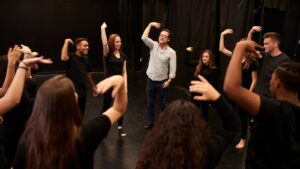By Maja-Barbara Kokot
The subtitle I borrowed from Hutchinson and Waters represents the gist of teaching English for Specific Purposes (ESP) and its guiding principle. ESP is not a recent phenomenon; it goes back in the late 1960’s. After the Second World War English became the key language for international commerce and technology thus creating a group of new learners who knew exactly why they wanted to learn it. Learning and consequently teaching English bent to their wishes, demands and needs. The focus was shifted from grammar-based teaching to the actual use of the language in communication. It focused on the question of what students learn rather than how they learn thus providing an insight into specific language needs.
»Tell me what you need English for and I will tell you the English that you need.”
(Hutchinson and Waters)
ESP in Slovenia
Language education policy within state schools defined by the Ministry of Education, Science and Sport in Slovenia follows the need to include the trends and demands of the rapid development of all professional fields into language teaching. The latter is reflected in classrooms, especially in vocational schools, such as ours. The Secondary school for Nurses Celje educates not only future nurses, but also beauticians. The curriculum for the English language, as their first foreign language curriculum, is divided into two parts. In the first two years students learn General English while in their third year they are introduced to ESP. ESP is continued to be taught through the fourth and final year. Therefore, in the final two years the focus of teaching is on the needs and expectations from the students’ future working environment. The aim is to enable the students to follow their professional field after their formal education, and to be able to communicate in English in spoken and written form.
The linguistic competences they have acquired after schooling are then examined at the final national exam called Poklicna matura (Vocational matura). Vocational matura is in accordance with the Common European Framework of Reference for Languages (CEFR), which means a nurse’s or a beutician’s level of English is B1 (intermediate), but there are quite a few who reach B2 (upper-intermediate). For detail description of each level see table-1-cefr-3.3-common-reference-levels-global-scale.
What do you do when there is no textbook to teach from?
Teaching medical English can be hard if you do not have the necessary knowledge and vocabulary in the field of anatomy, physiology and biology. When introducing English for nurses into classes, we did not encounter greater difficulties as we came across a very good textbook called Nursing published by Oxford University Press. It covers field-related vocabulary together with all the four linguistic skills. We have been using it for a number of years and the students like it as well. It makes possible for us to create meaningful and challenging lessons.
However, we had quite some difficulties finding an appropriate textbook for beauticians. There are few available, also online material created by teachers (for instance: new_competences/data/dokumentace/Skripta_kosmetika.pdf), but in Slovenia, textbooks have to be approved by a special board at the Ministry of Education otherwise they cannot be used in classes. Apart from that, these textbooks include hairdressing, which is not a field that beauticians in our country cover. Additionally, they focus primarily on vocabulary and listening comprehension while grammar is of lower priority, so honestly we did not find them of great use in the first place.
What we did was the needs analysis. “ESP courses are those where the syllabus and materials are determined in all essentials by the prior analysis of communicative needs” (Robinson, 1991). Then we searched for material on the web. We needed content that would also make linguistic form more meaningful. What we looked for were professional authentic texts dealing with specialized topics that are also related to other professional subjects the curriculum includes and in direct relation to the learners’ working situation. We needed to cross curricular with teachers of professional subjects such as dermatology, skin diseases, cosmetology and cosmetic products. I must confess I learnt a great deal of specific vocabulary and a lot of subject matter was new to me as well. Of course we had to modify the material bearing in mind the students have to acquire the vocabulary of the beauty services world and revise the grammar they had studied in the first two years.
As far as grammar forms are concerned we gave priority to those relevant to a range of situations students would encounter while working. To name some: the use of basic tenses (present/past simple, present continuous, present perfect simple, future simple, going to future), the use of passive to describe procedures and treatments, the use of modal verbs and the first/second conditional to give advice to clients.
We had to familiarize ourselves with the core vocabulary of the field of study, namely salon equipment, all sorts of hair and beauty treatments, make-up and its application, skin types, skin structure, skin functions, skin disorders and diseases. Through the years we have created materials, which we are still upgrading and modifying.
Example of a vocabulary exercise dealing with skin types
And the method?
As Prabhu said there is no best method to teach ESP as any method can be chosen in classrooms according to the context, learners, needs analysis, teaching standard and learning abilities. Teachers of ESP have to integrate the content and the language so we tailored English classes in a communicative way as much as possible. We greatly rely on the traditional role-play activity which has proved really useful. Students are able to assume their roles so easily, because they already have experience from practical lessons at school and from a three-week training course during the school year with their potential would-be employers in salons and spas. When given a particular task or problem solving situation, students never cease to amaze us with their performance. The ideas as well as the vocabulary some of them use often surpass our expectations. This is partly due to the fact they are very interested in their field, a lot of them educate themselves on-line without really realizing it when checking out novelties or following vloggers.

A role-play activity in specially designed classrooms that enable to make the students’ would-be working environment authentic.
Teaching ESP is definitely a challenge requiring quite a great deal of work on our part, but also allowes us to grow professionally. Do you have any experience or tips for ESP teaching?
References
- Hutchinson, T. and A. Waters. 1987. English for Specific Purposes: A learning-centred Approach. Cambridge: Cambridge University Press.
- Prabhu, N. S. 1990. There is no best method. Why? TESOL Quarterly. Volume 24, No 2.
- Robinson, P. C. 1991. ESP Today: A Practitioner’s Guide. Longman Phoenix Prentice Hall ELT






